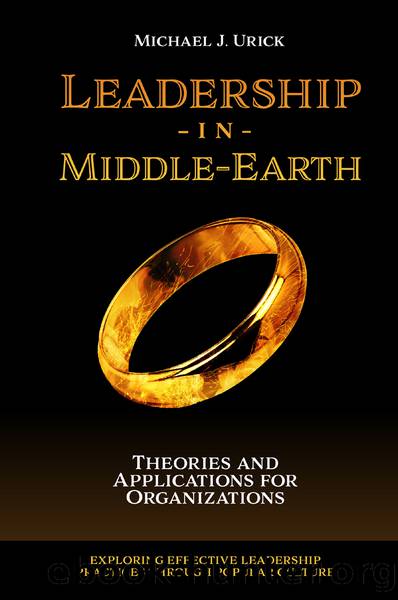Leadership in Middle-Earth by Urick Michael J.;

Author:Urick, Michael J.;
Language: eng
Format: epub
Publisher: Emerald Publishing Limited
Published: 2021-03-05T00:00:00+00:00
THE ROLE OF SONG
Actions are key ways in which characters (Samwise and Aragorn included) communicate in Middle-earth. A less subtle form of communication is explicitly through song, and both poetry and music are leveraged throughout Tolkienâs tales. There are several ways in which leaders use songs to influence followers.
One way in which a leader influences others can be through helping to create something and, in Middle-earth, songs are powerful tools of creation. For example, leaders work and communicate with others to accomplish a shared mission or goal and often this leads to some new creation. As illustrated in the creation of Middle-earth (and beyond) found in the opening of âThe Silmarillion,â song is a powerful enabler of creation. Early in this compiled work, the section entitled âAinulindalëâ illustrates how the Ainur help Eru Iluvatar, the supreme deity of Tolkienâs legendarium, to create the world and the heavens through joining in song. Thus, communication helps to create and, in this case, communication through song creates the entire universe.
But, song is creative on a smaller scale than a universe as well. Tolkienâs use of song also creates and strengthens cultures. The songs in Middle-earth tell stories which, in turn, reinforce a groupâs culture. Every group, whether a two-person dyad, a small team fellowship, or a nation state like Gondor, has a culture, which sets expectations of its members and carries on the groupâs collective traditions.
To paraphrase esteemed cultural research Edgar Schein (2017), a culture consists of three levels: assumptions, values, and artifacts. Assumptions are taken-for-granted beliefs and worldviews that are so deeply held and shared among a groupâs members that they are rarely (if ever) discussed. One reason behind a lack of discussion of assumptions is that sometimes they are so deeply ingrained in a group that they are difficult to articulate. Values are derived from a groupâs assumptions and are stated or enacted ideals, aspirations, goals, or principles that illustrate what the collective culture cares about. Artifacts are the physical manifestations of cultures that can be experienced with the five senses.
Artifacts are built upon values which, in turn, are built upon assumptions. In this way, artifacts are the ways that people physically experience what is important to a group of people within a culture. Artifacts help to illustrate to members of a group what normal and expected behaviors are. They also help to preserve the values of a group of people so that the culture can be passed on. In essence, artifacts help people to make sense of what is important in a culture.
In Middle-earth, songs are one type of artifact and these communicate aspects of cultures. The hobbits have songs about things that are important to them and they are often focused on beer or food which is telling of the culture of the Shire, their home. However, Bilbo also sings âThe Road Goes Ever On and Onâ which documents his philosophy of journeying. Bilbo is, of course, unique among most hobbits as many of the species have never left their homeland.
Download
This site does not store any files on its server. We only index and link to content provided by other sites. Please contact the content providers to delete copyright contents if any and email us, we'll remove relevant links or contents immediately.
| Conflict Resolution & Mediation | Human Resources & Personnel Management |
| Knowledge Capital | Outsourcing |
Bullshit Jobs by David Graeber(3193)
Radical Candor by Kim Scott(2235)
I Am Right, You Are Wrong by Edward De Bono(2111)
23:27 by H. L. Roberts(1896)
Nomadland by Jessica Bruder(1693)
Average Is Over by Tyler Cowen(1545)
High-Impact Interview Questions by Victoria A. Hoevemeyer(1405)
Out of Our Minds: Learning to Be Creative by Ken Robinson(1384)
The Conflict Resolution Phrase Book by Barbara Mitchell & Cornelia Gamlem(1350)
The Ideal Team Player by Patrick M. Lencioni(1319)
An Everyone Culture: Becoming a Deliberately Developmental Organization by Robert Kegan & Lisa Laskow Lahey(1301)
The Asshole Survival Guide by Robert I. Sutton(1288)
Automatic Society by Bernard Stiegler(1227)
Unleashed by Anne Morriss & Frances Frei(1224)
Who by Street Randy & Smart Geoff(1203)
42 Rules of Employee Engagement by Susan Stamm(1193)
Who Moved My Cheese?: An Amazing Way to Deal With Change in Your Work and in Your Life by Johnson Spencer(1181)
96 Great Interview Questions to Ask Before You Hire by Paul Falcone(1136)
The Power of Disability by Al Etmanski(1085)
